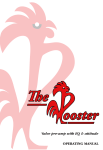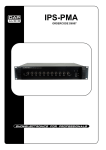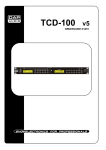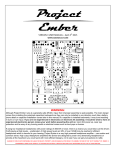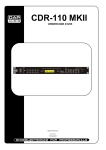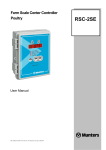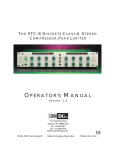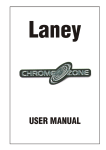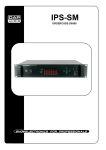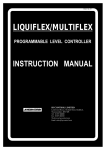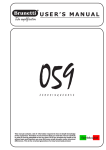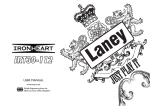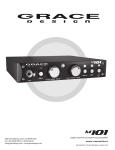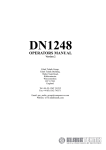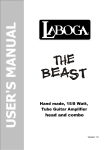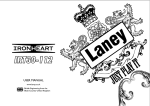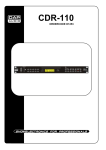Download warning - MusicToolz
Transcript
The Rooster device and logo copyright © 2007 Jon Bailes. All rights reserved. ©Thermionic Culture Ltd., May 2014 1 WARNING For your personal safety, please read this operating manual and warning thoroughly before using the equipment. This unit must be installed in such a manner that operator access to the mains plug is maintained. Where the product is to be rack mounted, this may be achieved by having access to the disconnection device for the whole rack. To reduce the risk of electric shock, it is essential that the unit is disconnected from the mains supply before removing the cover. Please also note that the power supply capacitors within this unit can remain charged even after the mains supply has been disconnected. It is essential that these capacitors are discharged after the mains supply has been disconnected and the covers have been removed. In the event that this unit has been dropped or has suffered an impact, an electrical safety test must be carried out before reconnection to the mains supply. This equipment is not intended for use in explosion hazard environments. It must be used and stored in studio conditions, such that the ambient relative humidity does not exceed 80%, nor is the temperature to be allowed to drop to a level, which would cause dew point to be reached. Please ensure that adequate ventilation is provided and that the ventilation slots are not obstructed. When rack mounting this equipment, a fan may be required to provide sufficient airflow. It is not advisable to operate this equipment if all valves are not in place and working, as voltages will rise and components may overheat and fail. ©Thermionic Culture Ltd., May 2014 2 CONTENTS Section Page 1 Introduction 3 2 Controls and meters 4 2.1 Phase switch 4 2.2 I/P switch 4 2.3 DI socket 4 2.4 I/P level control 4 2.5 Base lift control 4 2.6 Mid/Hi lift control 5 2.7 2.5k/4k/Hi switch 5 2.8 Mid Cut control 5 2.9 Bass Cut switch 5 2.10 LPF switch 6 2.11 Mode switch 6 2.12 Attitude switch 6 2.13 O/P level control 7 2.14 Off/48V switch 7 2.15 Meters 7 3 Operational hints and tips 8 4 Connections 9 5 Servicing and maintenance 10 5.1 Valves 10 5.2 Operating voltages and fuses 10 6 Specification ©Thermionic Culture Ltd., May 2014 11 3 1 Introduction The Rooster 2 is a valve device dedicated to bringing together three facilities in one unit. It provides a high quality Mic / DI / Line pre-amp, suitable for any type of microphone, DI or line source. Then comes a unique sounding award winning EQ section, specially designed by Vic Keary, comprising broad but very useable frequency bands with a ‘vari slope’ curve for bass and top. This is also a feature of the Earlybird 2 series of mic-amps. Finally, the ability to change the amount of distortion, or THD, of the unit as a whole is provided by the “Attitude” control, combined with the ‘Mode’ switch. All of these features are available on both of the unit’s 2 channels. The Rooster 2 will provide everything from a warm, clean sounding valve mic-pre, suitable for any application, to a characterful overdriven processor with powerful EQ, as adaptable for adding dirt and edge to mics as it is for mixdown treatment. The user has control over the amount of THD that The Rooster 2 will add to the signal as well as the kind of harmonics included in that THD. This is achieved by using a 5654 pentode valve. The control over gain given to the user can also be used to obtain more or less THD included in the output signal. In addition to this the EQ section can be used to tailor the sound of the distortion at high THD levels or it may act as a more conventional tone control at low distortion settings. ©Thermionic Culture Ltd., May 2014 4 2 Controls and meters 2.1 Phase switch Controls the absolute phase of the signal. The ‘NonInv’ position does not alter the phase of the signal applied to the input. Whereas, the ‘Invert’ position puts the signal at the output 180º out of phase with the input signal. 2.2 I/P switch In the ‘Mic’ position, the unit takes the input signal from the ‘Mic In’ XLR socket at the rear of the unit and gives up to 79dB of gain to a mic level signal. When set to ‘Line’ the unit takes the input signal from the ‘Line In’ XLR socket and gives up to 45.5dB of gain to a line level signal. 2.3 DI socket This socket provides an unbalanced, high impedance input for any low or instrument level input sources. This input will cut any other input when connected, so it will become the input to The Rooster 2 regardless of the position of the I/P switch. 2.4 I/P Level control The ‘I/P Level’ control gives continuously variable adjustment over the input gain of The Rooster 2 in whatever mode it is being used. 2.5 Bass Lift control The ‘bass lift’ control gives continuously variable adjustment over the amount of bass boost applied to the signal. The unique ‘vari slope’ bass lift curve can be thought of as a ‘shelving’ type curve at low amounts of boost. As the boost increases the low end ©Thermionic Culture Ltd., May 2014 5 ‘tips up’, giving an emphasis to lower frequencies and this adds an impression of size to the bass end. 2.6 Mid/Hi Lift control The ‘Mid/Hi Lift’ control gives continuously variable adjustment over the amount of mid or high frequency boost applied to the signal. The ‘2.5k/4k/Hi’ switch, described next, determines the actual frequency range being lifted. 2.7 2.5k/4k/Hi switch This switch provides the user with a very broad lift at 2.5 & 4kHz (highest peak frequencies) with some top lift as well and a ‘vari slope’ shelving type curve on the ‘hi’ setting. At maximum boost the peak point for the ‘hi’ setting will be 10kHz. 2.8 Mid Cut control The ‘mid cut’ control gives continuously variable adjustment over the amount of mid range frequencies being cut from the signal. The curve used is a bell shape curve that becomes sharper as more cut is applied. The centre of the curve is at 700Hz. 2.9 Bass Cut switch The ‘Bass Cut’ switch is a stepped control with the following options available :- · · · · · · 0 Flat response; 1 High pass filter operating below 30Hz; 2 6dB per octave curve, 3dB down at 120Hz; 3 6dB per octave curve, 3dB down at 350Hz; 4 Shelving curve, 3dB down at 800Hz; 5 Shelving curve, 3dB down at 3kHz Positions 2-5 have a steeper cut below 30Hz. ©Thermionic Culture Ltd., May 2014 6 2.10 LPF switch Switches a Low Pass Filter in or out of circuit after the distortion valve. This is included because, in situations where all stages of The Rooster 2 are being pushed into extreme distortion, it may be necessary to tame the excessive high frequency content created by the distortion itself. This control can provide a smoother kind of extreme distortion to the signal. This filter starts acting above 5kHz and is 6dB down at 10kHz. 2.11 Mode switch This switch determines whether The Rooster 2’s 5654 valve is to be used as a Triode or Pentode valve. Triode valves tend to give predominantly 2nd order harmonic distortion when driven hard whereas Pentode valves give predominantly more 3rd order harmonics. 2nd order harmonics will tend to sound smoother and 3rd order harmonics will give a more aggressive effect. 2.12 Attitude switch The ‘Attitude’ switch allows the user to determine how much distortion, or THD The Rooster 2 will add to the signal. At position ‘1’ The Rooster 2 is capable of delivering a very clean signal (well below 0.1%), but as the control is stepped towards ‘Max’ the distortion provided by The Rooster 2 will increase. This does also rely on the setting of the ‘I/P Level’ control, which if turned down will decrease distortion and when turned up increases distortion. With both controls set to maximum the distortion will be very extreme, and the output control will need to be reduced to a low level. ©Thermionic Culture Ltd., May 2014 7 2.13 O/P Level control The ‘O/P Level’ control is a continuously variable attenuator that controls the output level of The Rooster 2. A cleaner signal is obtained when the control is set to maximum. Turning the output control down towards minimum and driving the input of The Rooster 2 harder results in more distortion. 2.14 Off/48V switch The Off/48V switches located at the right hand side of The Rooster 2, control whether or not the 48V phantom power is applied to the ‘Mic In’ XLRs. This allows the use of phantom powered microphones. Please ensure that these are switched to the ‘Off’ position when using ribbon microphones or passive equalisers such as The Pullet. 2.15 Meters The meters read the output level of The Rooster 2 after the ‘O/P Level’ control, serving as a basic indication of the output level feeding the next piece of equipment in the signal chain. The nominal thresholds of each LED are as follows:Yellow Green Red ©Thermionic Culture Ltd., May 2014 -20dB -4dB +6dB 8 3 Operational hints and tips To use The Rooster 2 as a clean, high quality, valve mic amp. Set the ‘O/P Level’ control to '8', the ‘Attitude’ switch to ‘1’ and the 'Mode' to 'Triode', then use the ‘I/P Level’ control to obtain the desired amount of gain. If more gain is required simply increase the ‘Attitude’ switch and/or output level until the gain is satisfactory. The ‘LPF’ filter becomes especially useful when heavily distorting DI inputs, like bass instruments for example. As the distortion becomes extreme the high frequency content can start to sound more ‘clipped’ and stands out from the actual sound of the instrument. Using the ‘LPF’ filter will tame the problem frequencies and result in a smoother more musical sounding distortion, allowing the user to push The Rooster 2 into even more distortion if desired. The Rooster 2 can act as a subtle enhancer on mixdown. For example, a vocal sound can be given more life and cut through a mix better if a little overdrive is added plus some additional mid range or top EQ. Try the ‘Attitude’ switch at ‘4’ and add a little mid lift at 4k, the ‘Pentode’ setting will make the vocal slightly more aggressive if required. Drum microphones can benefit greatly from being recorded through The Rooster 2. A mic that is placed to capture the sound of the whole kit with a little room sound included would be ideal. The ‘Attitude’ can be increased to give a similar effect to compression. The ‘Bass Lift’ can also be used to give a very large bottom end to the drums. The ‘Triode’ and ‘Pentode’ settings will govern how smooth or harsh the user wants the overall effect to be. The bass lift and bass cut can be used together to shape the sound. Try heavy bass lift and bass cut at '4' or '5'. ©Thermionic Culture Ltd., May 2014 9 4 Connections There are 3 XLR connections per channel at the rear of The Rooster 2, plus one DI jack input per channel, on the front panel. ‘Mic In’ is a balanced input, which all microphones should be plugged into. The connector is a 3 pin female XLR. (The input signal should be applied to pins 2 and 3. Pin 1 is ground). ‘Line In’ is the female 3 pin XLR socket that any line level signals (+4 dBV) should be sent to. These inputs are balanced (see ‘Mic-In’ for connections). If an unbalanced source is used, Pin2 should be signal and pins 1 and 3 should be ground. ‘O/P’ is the male 3 pin XLR socket that the line level output signal (+4 dBV) appears at. The output is transformer 'balanced' (ie. floating) and can be equally well connected to a balanced or unbalanced piece of equipment. Pins 2 and 3 are signal and pin 1 is ground. ‘DI’ is the jack socket on the unit’s front panel. This provides a high impedance signal for all low level and instrument level signals. When this input is connected it will disable all other inputs on this channel and operate regardless of the position of the ‘I/P’ switch. ©Thermionic Culture Ltd., May 2014 10 5 Servicing and maintenance 5.1 Valves All valves are selected to ensure that the unit gives optimum and consistent performance across both channels. Although Thermionic Culture Ltd. guarantees the valves for twelve months, they can last up to 20 years. Spare valves can be obtained from Thermionic Culture Ltd. The Rooster 2 Valve complement is: Input: Distortion: Output: 5.2 12AX7 / ECC803 / ECC83 (2 off) 5654 (2 off) PCF 80 (2 off) Operating voltages / fuses The Rooster 2 can be set to operate from either 230V or 115V 50/60 Hz AC. The appropriate mains input voltage can be selected on the red switch located next to the mains inlet. Note: Mains fuses must be replaced in accordance with the following table. 230V 115V ©Thermionic Culture Ltd., May 2014 T315mA T630mA 11 6 Specification Measurements are made at ‘Attitude’ setting ‘1’. in Triode mode with an output of +4dBu. Measurements made with AC mains input 236V 50Hz. Load resistance is 10kΩ. Available gain (dB) Mic Line Frequency response ±1dB Distortion (THD @ 1kHz) Noise (unweighted, 30kHz filter) MOL (2% THD @1kHz) Phase shift Input impedance Mic Line DI Output impedance 56 (87 with Attitude at max. (P)) 24 10Hz to 45kHz ≤0.05% ≤95dB below MOL ≥+25dBu 24º (6.6%) at 10kHz 1kΩ 10kΩ 100kΩ unbalanced 600Ω 10kΩ is the ideal load impedance. The Rooster 2 will work into a load of 600Ω, but distortion will increase & MOL will be reduced. ©Thermionic Culture Ltd., May 2014 12 The Rooster - frequency response curves 20 2k5 lift(10) Hi Lift(10) 4k lift(10) Bass lift (10) Bass lift (7) Bass lift (3) Bass cut (1) Bass cut (2) Bass cut (3) Bass cut (4) Bass cut (5) Mid Cut(9) Mid Cut (5) LPF Gain (dBu) 10 0 -10 -20 -30 0.02 0. 1 1 Frequency (kHz) 10 100 Thermionic Culture Ltd., Harlow, Essex, UK Tel: +44 (0)1279 414770 email: [email protected] ©Thermionic Culture Ltd., May 2014. Printed in UK.















